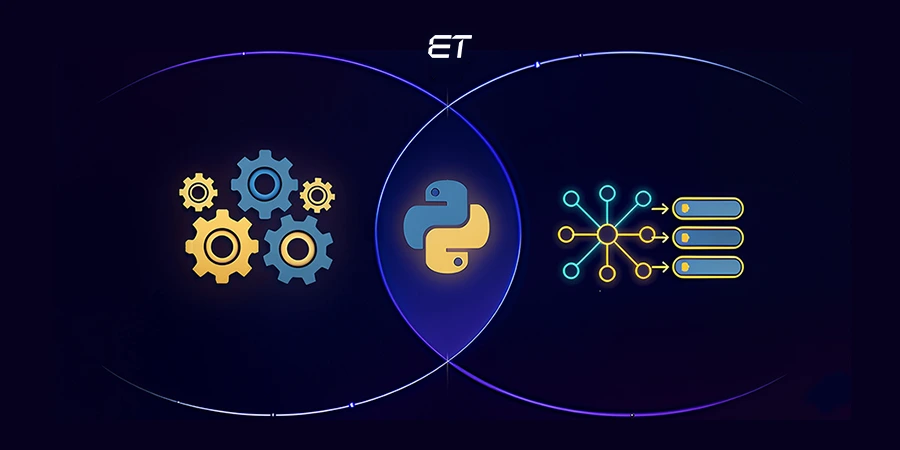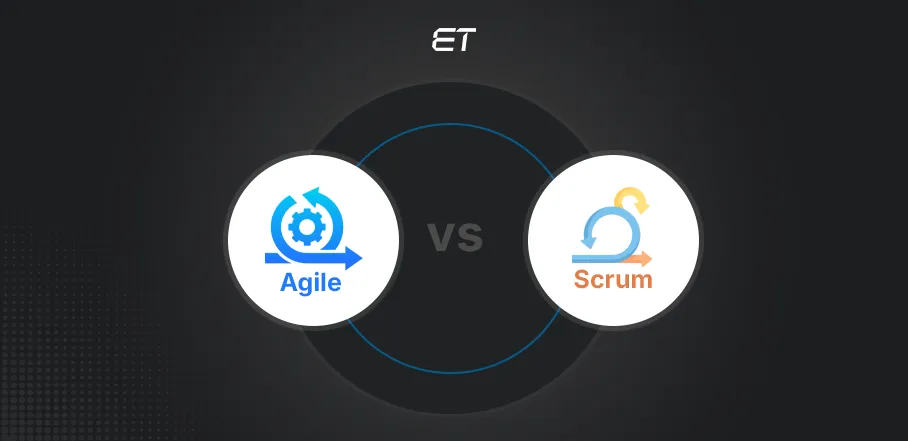
Agile vs Scrum: A Clear Guide to Choosing the Right Approach
- Agile philosophy emphasizes flexibility and collaboration, while Scrum is a specific, structured way to implement Agile principles.
- Scrum offers defined roles, events, and artifacts that provide a practical roadmap for teams.
- The best approach between Agile (in general) and Scrum depends on your project complexity, team size, and need for structure.
- Agile is adaptable to various situations, while Scrum provides a clear and prescriptive process.
- Both Agile and Scrum prioritize delivering value to the customer through iterative development.
We know what’s bothering you. It’s the pressure to be flexible yet structured while managing your project. In other words, it’s the dilemma of choosing Agile vs Scrum.
Recent data indicates that Agile provides 60% more revenue growth than other methodologies. So, is it a clear indicator of adopting this approach? Well, the answer might not be very straightforward.
Think of it this way: Agile is the philosophy while Scrum is a specific framework. Let’s break down the key differences and help you figure out which approach (or perhaps a combination) might be the perfect fit for your projects.
Ignite Results: Let’s Architect Your Agile Success!
Agile vs Scrum: The Differences in a Nutshell
Let’s break down Agile and Scrum across several key aspects to grasp the essential distinctions.
| Feature | Agile | Scrum |
| Nature | An overarching philosophy and a set of guiding principles for iterative and incremental development. | A specific framework for implementing Agile principles. |
| Scope | A broad mindset applicable to various aspects beyond software development. | Primarily focused on managing software and product development projects. |
| Prescriptiveness | Less prescriptive, offering general guidelines and values. | Highly prescriptive, with defined roles, events, artifacts, and rules. |
| Roles | Generally defines roles like ‘customer’ and ‘developer’ more broadly. | Clearly defines specific roles: Product Owner, Scrum Master, and Development Team. |
| Structure | Offers no specific methodology but encompasses various frameworks (including Scrum, Kanban, XP, etc.). | Provides a structured framework with specific ceremonies (Sprint Planning, Daily Scrum, Sprint Review, Sprint Retrospective). |
| Planning | Emphasizes iterative planning and adaptation throughout the project lifecycle. | Uses time-boxed Sprints with detailed planning at the beginning of each Sprint. |
| Change Management | Embraces change as a core principle and encourages flexibility. | Manages change primarily between Sprints; changes within a Sprint are generally discouraged. |
| Deliverables | Focuses on delivering working software frequently. | Emphasizes delivering a potentially shippable Increment at the end of each Sprint. |
| Guidance | Provides values and principles outlined in the Agile Manifesto. | Offers a detailed process with specific steps and guidelines for execution. |
What Exactly is Agile? The Philosophy Explained
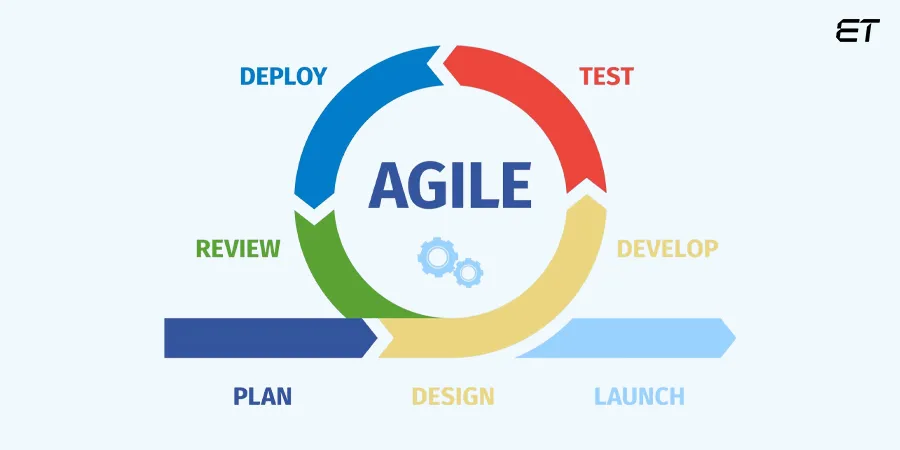
| Definition: Agile is an iterative and incremental approach to managing projects and developing products or services. |
This philosophy is built upon a set of core values and principles that emphasize:
- Collaboration
- Flexibility
- Continuous improvement
Born from the challenges of traditional, waterfall-based development in the late 20th century, Agile emerged as a response to the need for faster adaptation and higher customer satisfaction.
At its heart lies the Agile Manifesto, a document created in 2001 by a group of software developers who sought better ways of building software. This manifesto outlines four key values:
- Individuals and interactions over processes and tools.
- Working software over comprehensive documentation.
- Customer collaboration over contract negotiation.
- Responding to change over following a plan.
Key Takeaways about Agile:
- It’s a Mindset: Agile is less about specific steps and more about embracing a way of thinking and working.
- Focus on Value: The primary goal is to deliver value to the customer quickly and iteratively.
- Adaptability is Key: Agile methodologies are designed to thrive in environments where requirements are likely to evolve.
- Umbrella Term: Agile is an umbrella term encompassing various specific frameworks and practices, with Scrum being one of the most popular.
In essence, Agile provides the ‘why’ and the ‘what.’ It doesn’t prescribe the exact ‘how.’ (that’s where frameworks like Scrum come into play).
Embrace true agility, not just the motions. Discover the difference now!
The Benefits of Implementing Agile
The Agile philosophy is primarily centered around its inherent flexibility and adaptability. So, your teams can respond to evolving requirements and market dynamics. This iterative approach leads to improved customer satisfaction through frequent delivery and close collaboration.
Furthermore, Agile fosters enhanced team collaboration and communication, contributing to faster time to market and higher quality products through continuous feedback and testing.
The Challenges of Embracing Agile
While powerful, Agile implementation isn’t without its hurdles. The very flexibility that is a strength can become a challenge if you don’t manage scope creep.
Successful Agile adoption demands strong team collaboration and commitment, and scaling it for large, complex projects requires thoughtful planning. Moreover, embracing Agile often necessitates a significant shift in organizational culture, which can be a considerable undertaking.
Struggling with fixed web costs? Discover how Agile can be your secret weapon. Find out more!
Delving Deeper into Scrum: The Framework in Action
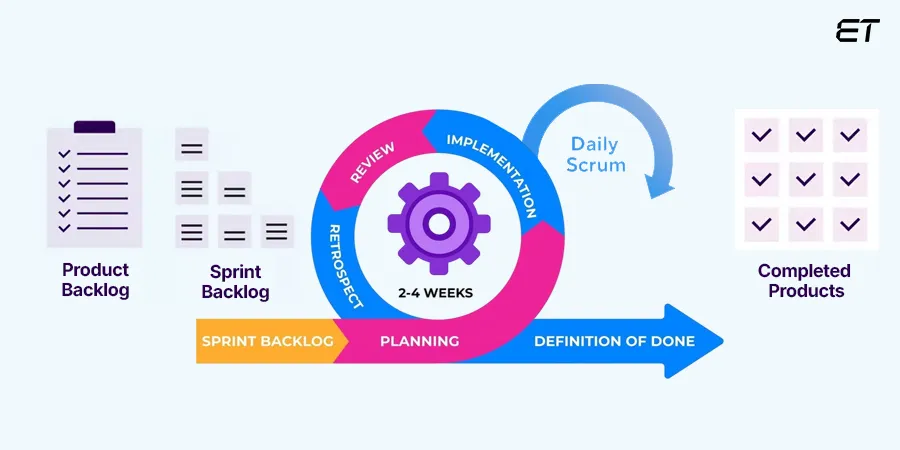
| Definition: Scrum is a specific framework within the Agile philosophy, designed for developing, delivering, and sustaining complex products. |
The key elements of the Scrum framework include:
- Roles: Clearly defined roles such as the Product Owner, the Scrum Master, and the Development Team.
- Events: Time-boxed meetings like Sprint Planning, the Daily Scrum, the Sprint Review, and the Sprint Retrospective.
- Artifacts: Tangible outputs like the Product Backlog, the Sprint Backlog, and the Increment.
- Sprints: Short, time-boxed iterations (typically 1-4 weeks) during which the Development Team works to create an Increment.
The main aspects of Scrum to consider are:
- It’s a Framework: Scrum provides a concrete structure and a set of practices to implement Agile principles.
- Emphasis on Structure: Unlike the more general Agile philosophy, Scrum has specific rules and guidelines.
- Time-boxed Iterations: Sprints provide a predictable rhythm for development and delivery.
- Team Empowerment: Scrum emphasizes self-organizing teams that manage their own work.
All in all, Scrum provides the ‘how’ to embody the ‘why’ and ‘what’ of the Agile philosophy. It offers a practical roadmap for implementing iterative and incremental development.
The Advantages of Scrum
Scrum offers numerous benefits by providing a clear structure for Agile implementation. Its defined roles and regular events lead to improved team collaboration and communication, while artifacts like the Product and Sprint Backlogs enhance transparency across the project.
The short, iterative Sprints allow for faster feedback loops and an increased focus on delivering value. Furthermore, the predictable Sprint cycles can lead to better predictability in delivery.
The Scrum Challenges to Tackle
Implementing Scrum requires a strong commitment to its framework, and deviations can diminish its benefits. For some teams, the defined roles and events might initially feel overly prescriptive.
The success of Scrum relies on an empowered and knowledgeable Product Owner, as well as a skilled Scrum Master who can effectively facilitate the process. The time investment in Scrum meetings also needs careful management to avoid becoming overhead. Finally, scaling Scrum to larger, more complex environments demands careful coordination and adaptation of the framework.
Wondering which development approach is right for you? Let’s explore the best options together!
Understanding the Relationship: Agile vs Scrum in Practice
The terms ‘Agile’ and ‘Scrum’ are often mentioned in the same breath, and for good reason. However, it’s vital to understand their relationship to leverage them for your projects. Think of Agile vs Scrum not as an ‘either/or’ scenario, but rather as a ‘parent-child’ relationship.
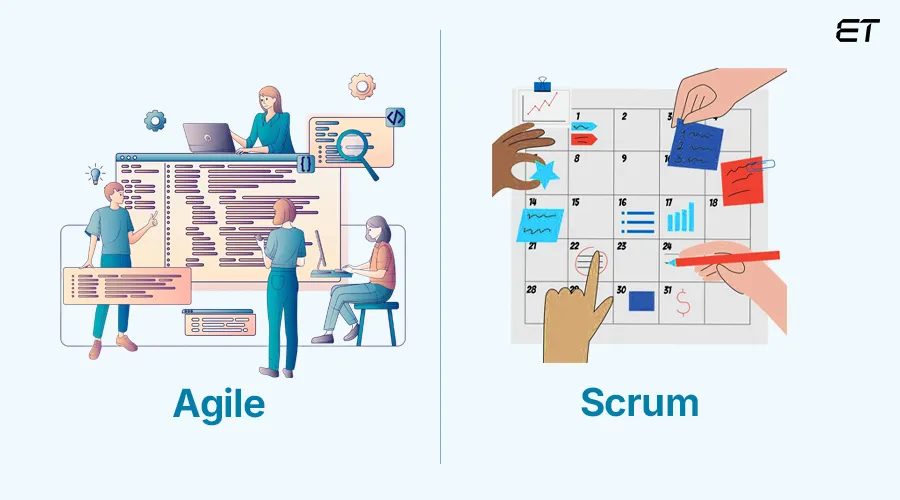
Agile is the ‘why’ behind a flexible and collaborative project management and development approach. When you talk about adopting an Agile methodology vs Scrum, you’re comparing a broad set of values and principles to a specific way of implementing those principles.

Scrum, on the other hand, is a specific framework. It is a set of defined roles, events, artifacts, and rules that provide a structured way to implement the Agile principles. Therefore, when considering Scrum vs Agile, remember that Scrum is a way to be Agile.
There are other Agile frameworks, such as Kanban, Lean, and Extreme Programming (XP), but Scrum is the most popular.
So, when teams talk about ‘Scrum vs Agile development,’ they are often discussing whether to implement the specific Scrum framework or perhaps another Agile approach. In many cases, adopting Scrum is the way a team chooses to implement Agile principles in their software development efforts.
Agile vs Scrum: Key Analogy
Imagine ‘Democracy’ as Agile. It’s a set of values and principles about how a government should function.
‘Parliamentary System’ is Scrum. It is one specific framework that represents the principles of democracy. There are other democratic systems, like a presidential system, just as there are other Agile frameworks besides Scrum.
In essence:
- You can be Agile without strictly following Scrum (by using another Agile framework).
- However, you cannot implement Scrum without adhering to Agile principles.
Scrum is designed from the ground up to express the values and principles of the Agile Manifesto. Understanding this relationship is the first step in determining which approach, or a combination of approaches, is suitable for your team and your projects.
Agile vs Scrum: Decoding the Fundamental Differences

The key to the Agile methodology vs Scrum comparison lies in their nature and level of prescriptiveness. Here’s what you should know:
Agile is a Philosophy
It’s a set of values and principles outlined in the Agile Manifesto that guide how you approach work.
Agile doesn’t dictate specific processes or roles. Instead, it encourages teams to find the best way to embody these principles in their unique context. When considering scrum vs agile development, remember that Agile is the broader category, and Scrum is one specific methodology within it.
Scrum is a Framework
It provides a detailed structure with specific roles (Product Owner, Scrum Master, Development Team), events (Sprint Planning, Daily Scrum, Sprint Review, Sprint Retrospective), and artifacts (Product Backlog, Sprint Backlog, Increment).
Scrum dictates how the team should organize, plan, execute, and review their work within short, time-boxed iterations called Sprints. When teams discuss Scrum vs Agile, they are comparing a structured implementation framework against a more general set of guidelines.
The End Verdict
Here’s how you differentiate Agile vs Scrum:
- Agile: The reasons for being flexible and iterative, and the core values to guide you.
- Scrum: The practices and structures to implement the Agile philosophy.
Therefore, when you’re considering Scrum vs Agile development, you’re deciding whether to adopt the specific Scrum framework or explore other Agile frameworks (like Kanban or XP) that also adhere to the Agile principles but have different structures and rules.
In essence, all Scrum implementations are Agile, but not all Agile implementations are Scrum.
Ever wondered how Agile and DevOps truly work together? Let’s clear up the confusion and boost your team!
Agile vs Other Methodologies
So, you’re getting a good handle on the Agile vs Scrum conversation, right? However, to truly appreciate the power and flexibility of Agile, it’s helpful to see how it stacks up against more traditional ways of managing projects.
Think about it: for years, projects followed a much more linear path. So why the shift? Why all this talk about iterations and collaboration?
Well, that’s what we’re going to explore in this section. Understanding the contrast between Agile and other methodologies gives you a clearer perspective on its strengths and when it truly shines.
Let’s dive in and look at how Agile differs from other common approaches.
Agile vs Waterfall

When we talk about Agile vs Waterfall, we compare two distinct approaches to project management.
- Waterfall is a linear, sequential methodology. You complete each phase of the project one after the other.
- Once a phase is finished, you typically don’t go back.
- This approach relies heavily on upfront planning and assumes that the requirements will remain relatively stable throughout the project lifecycle.
Agile, in contrast, is an iterative and incremental approach.
- Instead of one big, sequential process, the project has smaller cycles called iterations or sprints.
- Within each iteration, the team works on a specific set of features, delivering a working piece of the product.
- A key aspect of Agile is its ability to adapt to change. Requirements can evolve throughout the project, and the team adjusts its plans based on feedback and new information.
This aspect makes Agile much more flexible than Waterfall, especially in environments where the final product isn’t fully defined at the outset or where changes are likely.
Overall, Waterfall prioritizes detailed upfront planning and sequential execution, while Agile emphasizes flexibility, iterative development, and continuous adaptation.
Agile vs Kanban
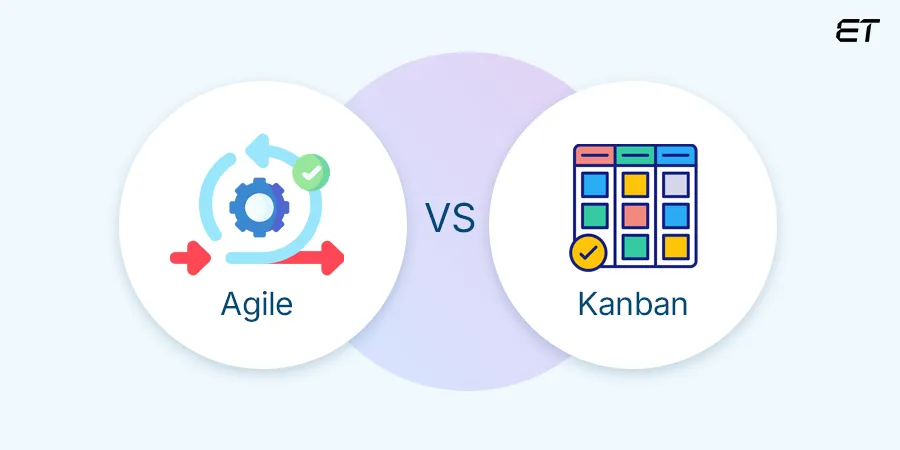
When you’re looking at Agile vs Scrum, you might also encounter Kanban. While both are Agile approaches, they differ in their structure and flow.
- Agile emphasizes time-boxed iterations (Sprints) with a defined start and end.
- Teams commit to a set of work for each Sprint, and progress is measured within these cycles.
- There’s a focus on specific roles and events within these iterations.
Kanban, on the other hand, is a flow-based system.
- It focuses on visualizing the workflow, limiting work in progress (WIP), and continuously improving the flow of work.
- Unlike Scrum’s time-boxed Sprints, Kanban is more of a continuous flow where work moves through different stages of a board.
- There are no fixed iterations or roles like Scrum Master or Product Owner.
Kanban is about optimizing the delivery pipeline and reducing bottlenecks by managing the amount of work being done at any given time.
So, while both Agile and Kanban value flexibility and continuous improvement, Agile implies structured iterations, while Kanban emphasizes a continuous, visualized flow.
Agile vs Scrum: Making the Right Choice

Okay, so we’ve journeyed through what Agile vs Scrum are and how Agile stacks up against other ways of getting things done.
Now comes the big question: which path should you take? Choosing between the broader Agile methodology and the specific Scrum framework boils down to what your project and team look like.
Let’s think through some common scenarios together:
| Consider This… | Your Potential Path |
| Need for Structure and Specific Guidance? | Scrum: If you need a well-defined framework with clear roles, events, and rules to guide your team’s process |
| Project Complexity and Change Expectation? | Agile: If your project is highly complex, requirements are likely to change, and you need a flexible approach to adapt. |
| Team Size and Self-Organization Level? | Scrum: Generally works best with smaller, cross-functional teams that can effectively self-organize within the Scrum framework. |
| Organizational Readiness and Cultural Shift? | Agile: You can adopt more incrementally, and this approach might be a better starting point for organizations that are less familiar with iterative development. |
| Emphasis on Predictability and Time-boxed Delivery? | Scrum: Offers more predictable delivery cycles within Sprints, which can be beneficial for planning and stakeholder communication. |
| The desire for Strong Customer Collaboration? | Agile: Both emphasize this, but Agile’s principles broadly encourage continuous collaboration and feedback integration. Scrum formalizes it within reviews. |
| Tolerance for Ambiguity vs Defined Process? | Agile: Offers more flexibility and allows teams to define their own processes based on Agile principles.
Scrum: Provides a specific, less ambiguous process to follow. |
| Speed of Initial Adoption? | Agile: Can start with adopting core principles and gradually incorporating practices.
Scrum: Requires a more upfront and complete adoption of the framework. |
In a Nutshell
The discussion around Agile vs Scrum isn’t about choosing a winner but understanding how they work together. Remember, Agile provides the values of flexibility, collaboration, and continuous improvement that help you navigate the complexities of modern projects.
Scrum, on the contrary, is a powerful framework that offers a structured way to put those Agile principles into practice with its defined roles, events, and artifacts.
The right choice for your team depends on your specific context: the complexity of your projects, the size and structure of your teams, your organizational culture, and your need for structure and predictability. Whether you embrace the broader Agile methodology and tailor your own approach or dive into the specifics of Scrum, the goal remains the same: to deliver value effectively and adapt to change.
By understanding the fundamental differences and the relationship between Agile vs Scrum, you’re equipped to choose the option that will lead to greater project success.
Got a project in mind? Let’s chat about how we can help you succeed.
Frequently Asked Questions
1. Is scrum part of agile?
Absolutely! Think of Agile as a philosophy, the set of guiding principles for working in a flexible and iterative way. Scrum is one of the most popular frameworks that helps teams implement those principles in their day-to-day work.
2. I understand Agile vs Scrum. Which is better if I have a startup?
That’s a great question. For startups, implementing the core Agile principles like flexibility and customer collaboration is beneficial as you navigate uncertain terrain. You might then find that Scrum’s structured framework helps bring organization and focus as your team grows and your product evolves.
3. Does eLuminous have an agile development team?
Yes, at eLuminous, we pride ourselves on our agile development teams! We leverage the principles of Agile and employ frameworks like Scrum to deliver flexible, collaborative, and high-quality solutions for our clients.
4. Who wins in Agile vs Scrum?
It’s not really about winning! Agile is the ‘why’ and ‘what,’ while Scrum is a specific ‘how.’ The best approach depends on your project goals, team dynamics, and organizational context. A practical approach is understanding both and choosing the right fit for your needs.



